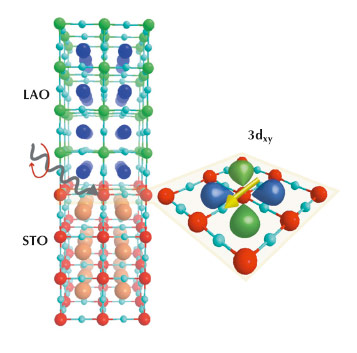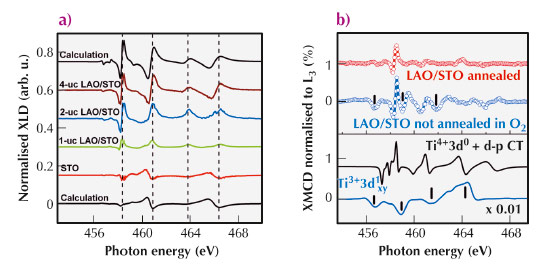- Home
- Users & Science
- Scientific Documentation
- ESRF Highlights
- ESRF Highlights 2013
- Electronic structure and magnetism
- Orbital reconstruction and interface magnetism in SrTiO3 based heterostructures
Orbital reconstruction and interface magnetism in SrTiO3 based heterostructures
The electronic properties of the 2D electron system created at the LaAlO3/SrTiO3 (LAO/STO) interface [1] hold promise for applications in oxide electronics. This system features especially striking properties, like electric field tuneable Rashba spin orbit coupling, superconductivity [2] and magnetism [3]. The mechanism leading to such phenomena is a subject of lively debate. While many experimental results are consistent with the so-called “polarisation catastrophe” mechanism, other hypotheses have been considered including a metallic state induced by stoichiometric defects. In particular La/Sr substitution and oxygen vacancies influence the LAO/STO properties by localising electrons in Ti3+ states, thus affecting the transport properties of the 2D electron system. It has been suggested that these Ti3+ electrons could induce exotic magnetic order, possibly coexisting with superconductivity [4].
To clarify these issues we used X-ray absorption spectroscopy (XAS) at the titanium L2,3 edge to study the orbital anisotropy and the magnetism of Ti-3d states of LAO/STO heterostructures deposited by pulsed laser deposition at the University of Geneva and at the University of Augsburg. The experiments were performed at beamline ID08. We studied standard LAO/STO samples, grown in oxidising conditions (P[O2] = 8 x 10-5 mbar) and annealed in 200 mbar of O2 after the deposition, and non-standard LAO/STO which were not annealed after the deposition to introduce some amount of oxygen vacancies and associated localised Ti3+ states.
 |
|
Fig. 109: a) Schematic of the XAS, XLD and XMCD experiments on LAO/STO heterostructure. LD is able to determine the orbital anisotropy of the system while XMCD is able to determine the magnetic moment of titanium-sites. In the figure, we show the case of an electron occupying a Ti3+ 3dxy state. |
A conceptual schematic of the experiment is presented in Figure 109 and a summary of the experimental results is shown in Figure 110. The linear dichroism spectra of Figure 110a are defined as the difference between XAS acquired with linear polarisation perpendicular and parallel to the interface, which select out-of-plane (dxz, dyz, and dz2) and in-plane (dxy, dx2-y2) XAS final states respectively. The data demonstrate that an inversion of the orbital hierarchy is obtained at the LAO/STO interface as soon as one complete LAO layer is deposited on top of a TiO2-terminated STO. In particular, the LAO/STO heterostructures have 3dxy orbitals being lower in energy than 3dxz,yz, opposite to bulk STO. This orbital reconstruction is accompanied by a substantial relaxation of the STO atomic layers even before the appearance of a mobile electron system, as shown by a refinement of surface diffraction data acquired at the ID03 beamline. Thus the orbital inversion does not only involve the fraction of titanium sites occupied by electrons (and having a Ti3+ valence) but rather all of the titanium sites at the interface.
 |
|
Fig. 110: a) XLD (Ic-Iab) at 8 K as function of the number of LAO layers and comparison with multiplet scattering calculations for anisotropic Ti4+ in STO (bottom black-line) and LAO/STO (upper black-line). (b) X-ray magnetic circular dichroism (8 K and B = 5 T parallel to the interface (grazing incidence)) for annealed LAO/STO (red circles) and LAO/STO containing oxygen vacancies (blue circles). Calculated XMCD using multiplet scattering theory for Ti4+ + Charge Transfer (CT) (black-line) and localised Ti3+ (blue-line). A negative exchange of 10 meV was used for the Ti4+ component while a positive exchange (Ti3+ spins parallel to the external magnetic field) reproduces the features observed in the data for an LAO/STO interface containing oxygen vacancies. The black sticks label the position of the Ti3+ features. |
Interfacial magnetism was investigated by X-ray magnetic circular dichroism (XMCD). Since empty Ti4+ sites are non-magnetic, we do not expect any XMCD signal from STO. Any magnetic signal should come either by localised Ti3+ spins, either by itinerant electrons or by electrons in charge transfer states. Electrons in the conduction band can couple to these localised spins by screening the impurity sites (as in a Kondo-metal) or by mediating a magnetic interaction between far away magnetic moments following an RKKY scheme. Figure 110b presents a comparison between the XMCD data acquired on oxygen annealed and non-annealed LAO/STO samples at 5 T and 8 K. Similar data were obtained at the X-TREME beamline of the Swiss Light Source. The data show that any ordered magnetic moment is very small in the case of optimally oxygenated LAO/STO interfaces. On the other hand, samples containing oxygen vacancies have Ti3+ localised spins, as seen by features resonating with energies typical of t2g Ti3+ XAS peaks. Together with the Ti3+ signal, we observe also features resonating at the main Ti4+ peaks. The latter reflect the contribution to the XMCD from electrons in charge transfer Ti3d-O2p states, including itinerant electrons of the 2D electron system. The sign of the XMCD contribution reveals that the exchange coupling with localised Ti3+ is negative. Thus the data show that the localised Ti3+ impurities induced by oxygen vacancies interact with the 2D electron system with an antiferromagnetic exchange coupling.
Since a magnetic moment is detected only in the case of samples containing oxygen vacancies, magnetism is not an intrinsic property of this system. An alternative explanation should invoke magnetism not coming from Ti-states, or some exotic magnetic order with average null magnetisation, such as the spiral order proposed in [5].
Principal publications and authors
M. Salluzzo (a), S. Gariglio (b), X. Torrelles (c), Z. Ristic (a), R. Di Capua (a), J. Drnec (d), M.M. Sala (d), G. Ghiringhelli (e), R. Felici (d), and N.B. Brookes (d), Advanced Materials 25, 2333 (2013); M. Salluzzo (a), S. Gariglio (b), D. Stornaiuolo (b), V. Sessi (d), S. Rusponi (f), C. Piamonteze (g), G.M. De Luca (a), M. Minola (e), D. Marrè (h), A. Gadaleta (h), H. Brune (f), F. Nolting (g), N.B. Brookes (d) and G. Ghiringhelli (e), Physical Review Letters 111, 087204 (2013).
(a) CNR-SPIN and Università di Napoli (Italy)
(b) Département de Physique de la Matière Condensée, University of Geneva (Switzerland)
(c) Institut de Ciencia de Materials de Barcelona (CSIC) (Spain)
(d) European Synchrotron Radiation Facility (France)
(e) CNR-SPIN and Dipartimento di Fisica, Politecnico di Milano (Italy)
(f) Ecole Polytechnique Fédérale de Lausanne, (Switzerland)
(g) Swiss Light Source, Paul Scherrer Institut (Switzerland)
(h) CNR-SPIN and Dipartimento di Fisica, Università di Genova (Italy)
References
[1] A. Ohtomo and H.Y. Hwang, Nature 427, 423 (2004).
[2] N. Reyren et al., Science 317, 1196 (2007).
[3] A. Brinkman et al., Nature Materials. 6, 493 (2007).
[4] 1 J.A. Bert et al., Nature Physics 7, 767 (2011).
[5] 1 S. Banerjee, O. Erten and M. Randeria, Nature Physics 9, 626 (2013).



